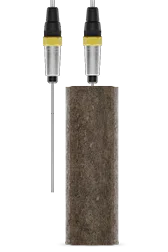Join us at the International Thermal Conductivity Conference (ITCC) and the International Thermal Expansion Symposium (ITES).
The TLS-100 is a portable meter used to measure thermal conductivity and thermal resistivity of a variety of samples, including soil, rocks, concrete, and polymers.
Best For Soil, Rock, Concrete, and Polymers
Standard Test
Method
Temperature
Range
The TLS-100 is a portable meter used to measure thermal conductivity and thermal resistivity of a variety of samples, including soil, rocks, concrete and polymers. Tests are performed with the push of a button and results are displayed instantly. The TLS-100 features sensors that are auto-recognized with corresponding testing parameters automatically loaded.
The TLS-100 follows ASTM D5334-22a and IEEE 442-2017. The sensor needle consists of a thin heating wire and temperature sensor sealed in a 150, 100 or 50 mm steel tube. The sensor is completely inserted into the sample to be tested. Heat is delivered to the sample using a constant current source (q) and the temperature rise is recorded over a defined period of time. The slope (a) from plot of temperature rise versus logarithm of time is used in the calculation of thermal conductivity (k). The higher the thermal conductivity of a sample, the lower the slope. For samples of low thermal conductivity, the slope will be higher.

| Method | TLS-100 (Included) | TLS-50 | TLS-150 |
| Materials | Soils, pastes, powders and solids | Concrete, rocks and polymers | Soils, pastes, powders and solids |
| Measurement capabilities | Bulk properties | Bulk properties | Bulk properties |
| Thermal conductivity (W/m·K) | 0.1 to 5 | 0.3 to 5 | 0.1 to 3 |
| Thermal resistivity (mK/W) | 0.2 to 10 | 0.2 to 3.3 | 0.3 to 10 |
| Measurement time | 3 minutes | 3 minutes | 3 minutes |
| Smallest sample size | 100 mm in length, 50 mm in diameter | 50 mm in length, 50 mm in diameter | 150 mm in length, 50 mm in diameter |
| Largest sample size | Unlimited | Unlimited | Unlimited |
| Accuracy | 5% | 5% | 5% |
| Reproducibility | 2% | 2% | 2% |
| Temperature (°C) | -40 to 100 | -40 to 100 | -40 to 100 |
| Standard | ASTM D5334-22a, IEEE 442-1981 | Modified ASTM D5334-14 | ASTM D5334-14, IEEE 442-2017 |

Each TLS-100 comes equipped with the standard 100 mm sensor for testing of soil, soft materials, polymers, and easy to drill materials. The needle sensor is fully inserted into an isothermal sample and a measurement is made with the push of a button. After 180 seconds, results are displayed for thermal conductivity and thermal resistivity. Saved results can also be exported to a computer, via convenient utility software and USB connection.
Soil thermal dryout curves can be prepared by measuring the thermal conductivity of a sample at different moisture contents, as the sample dries from saturation. The typical drying approach involves heating the soil at an elevated temperature. The sample is removed, weighed, and measured for thermal conductivity at different time intervals, until it is fully dried.

The 50 mm sensor was designed for testing hard samples, like rock and concrete. Drilling the required 4 mm diameter x 50 mm hole in rigid samples is easy with the provided masonry drill bit. When testing hard samples, a thermal contact grease is used to enhance contact between the sensor and sample.

The optional 150 mm sensor is used for in-lab and in-field testing of soil and soft materials according to IEEE 442-2017. The needle is fully inserted into an isothermal sample and measurement is made with the push of a button. After 180 seconds, results are displayed for thermal conductivity and thermal resistivity.
Conference Report The 3rd International Conference on Energy Efficiency in Historic Buildings
Energy efficiency in old building is very dependent upon how much heat is escaping through the walls. To determine this it is imperative to know the thermal conductivity of certain solid stone walls. This paper focuses on investigating the properties of some types of common stones used in traditional masonry of Scotland. The TLS-100 device is used to calculate the thermal conductivity of these stones via the transient line source method.

Recommended for use when testing solids such as rocks, concrete, or polymers.
We are happy to arrange a live demonstration for you!




